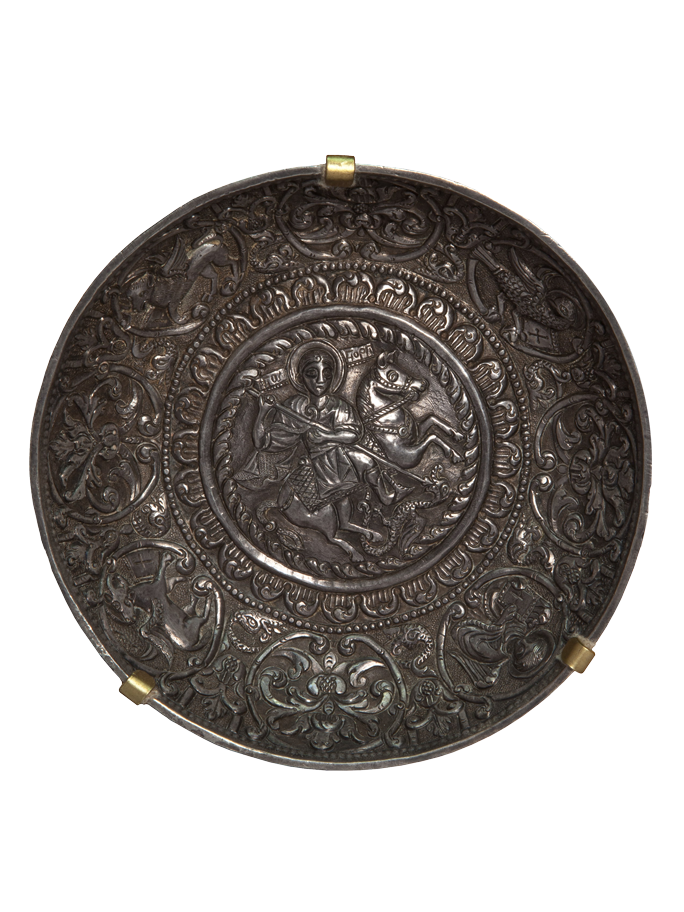THE BOWL OF PRINCE GEORGE (YURI) DMITRIEVICH

The bowl was found in the talus of a rampart on the ancient Mikulino hillfort. In the XIV – XV centuries, the hillfort of Mikulino was a center of a apanage principality, one of the largest in the Tver land. The bowl is made of pure silver and weighs 23 zolotniks that is circa 98 grams. The inner surface of the bowl is covered with chased ornamentation, twining brands in which the winged symbols of the evangelists alternate with lush plants. At the bottom of the bowl, a “rider” on a horse is depicted in relief, striking with a spear a a dragon that fell on its back. Near the head of the rider there is an inscription in Greek "HOLY GEORGE". And outside at the bottom of the bowl is a complex inscription in Russian, which stands for: "the Great Duke George" The owner of the bowl was prince of Galich and Zvenigorod Yuri (George) Dmitrievich, the second son of Dmitry Donskoy, a successful commander and a clever politician. Events of feudal war of 30-40-ies of the XV century, clashes for the "Moscow throne" between the Grand Duke Vasili II the Dark and Yuri Dmitrievich are connected to the bowl.
More information...The bowl was found on the ancient Mikulino hillfort. In the XIV – XV centuries, the hillfort of Mikulino was a center of a apanage principality, one of the largest in the Tver land. Its first duke was in 1363 Michail Alexandrovich. During his reign in Mikulino was built a rampart that remained till our days and a wooden fortress stronghold. In the talus of the rampart in 1850 the bowl was found, probably it was a part of a hoard. Luckily the bowl was not loss for science: at first it belonged to the owners of Mikulino of those times, then it was in hands of antiquarians and finally appeared in the Historical museum. The bowl is made of pure silver and weighs 23 zolotniks that is circa 98 grams. The inner surface of the bowl is covered with chased ornamentation, twining brands in which the winged symbols of the evangelists alternate with lush plants. At the bottom of the bowl, a “rider” on a horse is depicted in relief, striking with a spear a a dragon that fell on its back. Near the head of the rider there is an inscription in Greek "HOLY GEORGE". And outside at the bottom of the bowl is a complex inscription in Russian, which stands for: "the Great Duke George". Famous Russian numismatist Aleksey Vasilevich Oreshnicov proved persuasively that the owner of the bowl was prince of Galich and Zvenigorod Yuri (George) Dmitrievich, the second son of Dmitry Donskoy, a successful commander and a clever politician. Events of feudal war of 30-40-ies of the XV century, clashes for the "Moscow throne" between the Grand Duke Vasili II the Dark and Yuri Dmitrievich are connected to the bowl.
Evidence of the reign of Yuri Dmitrievich in Moscow: he became the Grand Duke of Moscow twice, in 1433 and 1434, there were coins with the image of the rider hitting the serpent - St. George, with his name and the title of Grand Duke. But his sitting on the “Moscow throne” turned out to be quite short: prince died suddenly and was succeeded by his son Vasily Yuryevich, who went down in history under the name Kosoy (he was blinded by Vasili the Dark). Kosoy was reigning in Moscow only for a month. When the army of Vasily II came close to the city, he run away from Moscow and took treasury of his father, and during his travels on Tver land, he hid the treasures in the Mikulino hillfort.
Made by a subtle artist-jeweler, similar in style to the works of medieval art from the Mediterranean and the Balkans, the bowl became an interesting artifact keeping memory of the history of cruel strife.
